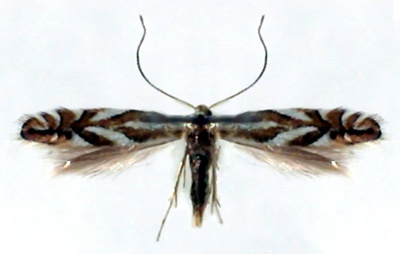Pests
Phyllonorycter blancardella (Fabricius) - Spotted Tentiform Leaf Miner
Systematic position.
Class Insecta, order Lepidoptera, superfamily Gracillarioidea, family Gracillariidae, subfamily Lithocolletinae, genus Phyllonorycter.Synonyms.
Lithocolletis blancardellus F., Lithocolletis concomitella Bnks., Lithocolletis pomifoliella Z.Biological group.
Polyphagous pest of rosaceous fruit trees and bushes.Morphology and biology.
Small moth with narrow forewings covered with golden hairs and silvery transversal stripes (wingspan 3.5 mm). Females somewhat larger than males. White egg is 0.3 mm. Caterpillar has five age stages. Younger caterpillars are pale green, older ones yellow. Caterpillars of younger instars have smooth, wedge-shaped head capsule; their body is also smooth and 1-2 mm in length. Caterpillars of 4-5th instars have more cylindrical body (length of 3.9 mm) and more oval head. Pupa brown, 3.3 mm in length. Pupae winter in dense cocoons inside mines within fallen leaves under trees. Female lays eggs usually one by one per young leaf, (seldom by 2 or more), always on the lower surface, between median and basis of secondary veins in basal third of leaf plate, the area of growth. Average fertility of the moths is 16 eggs at 10°S and 54 at 18°S. In Armenia, average fertility of the female is 17-20 eggs, maximum 26. At temperature 20°S and 71% relative humidity of air, eggs develop 9-10 days, caterpillars 20-27 days; pupae develop 9-10 days at temperature 18°S and humidity 70%. Oval mines are always located on the lower side of leaves, adjoining to middle rib or laying between secondary veins. Caterpillars of 1st-2nd instars form narrow bent epidermal mines. They eat mainly juices in this period. In 4th instar, they pass to feeding by parenchyma, spot-like mines thus become folded, being of the same size. Six mines per sheet occur at strong infection, and mines can coalesce, which leads to cannibalism and destruction of part of population.Distribution.
Western Europe, Asia Minor, Iran, Mongolia, Northern America (southeast Canada and northeastern states of the USA). In the former USSR, the species is distributed in the European part (except for the north and east), within the limits of apple area; i.e., in Baltic States, Byelorussia, Ukraine, Moldova, the European part of Russia, Transcaucasia, Urals. Records of the species in Siberia and the Far East of Russia belong to other species of the genus.Ecology
The species is bivoltine in Byelorussia, trivoltine in the south of Ukraine and in the Northern Caucasus and Transcaucasia. Moths of the wintered generation start to fly from the middle (Armenia) or the end of April (Byelorussia), during the beginning of apple leaf blossoming. In Byelorussia, the start of mass flight is synchronized with the period of bud blossoming and red bud growth stages, coinciding with the period of flowering of bird cherry. Imago flight of summer generation moths lasts until October. Moths live more than 2 weeks; they are active in the evening, beginning to fly at 1800 p.m., finishing with the approach of darkness. They fly from branches to leaves, sometimes aggregating on trunks. Optimum temperature for oviposition is 26°C. Fertilized females begin egg laying in the following night after copulation. Sum of degree days 172 is necessary for egg development at the lower temperature threshold of development 9°C. The sex ratio depends on temperature and on population density.Economic significance.
Caterpillars mine leaves of cultural and wild rosaceous pome plants, especially apple and quince, and less often pear, hawthorn, biwa, shadberry, mountain ash. They were marked on plum and cherry. Harming activity is defined by a complex of factors, including population density, fodder plant variety, geographical area and growth conditions of cultures. On early apple varieties, 2 mines per sheet stimulate premature ripening and dropping of apples, and 4 mines per sheet decrease the fruit size. Control measures are as follows: Agronomical ones are destruction of dry leaves; autumn interrow treatments of ground in orchards for destruction of pupae, thinning of tree branches. Biological measures are application of microbiological preparations and pheromone traps. Chemical measures are insecticide treatments of fruiters at detection of caterpillars on leaves.Reference citations:
Arakelyan A.O. & Saakyan Z.A. 1975. To biology of Phyllonorycter turanica and Phyllonorycter blancardella and to their control in northeastern Armenia. In: Mamedova S.R., ed. Materials of 7th session of Transcaucasian board on coordination of research works on plant protection. Kirovabad: NIIZR AzerbSSR, p.69-71 (in Russian).Bolotnikova V.V., Kurbyko L.M. & Yushkevich R.K. 1979. To biology of mining moths damaging fruit plantations in Byelorussia. In: Lopatin I.K., ed. Fauna and ecology of insects of Byelorussia. Minsk: Nauka i tekhnika, p. 19-21 (in Russian).
Gershenzon Z.S. & Kholchenkov V.A. 1974. Family Lithocolletidae. In: Vasil.ev V.P., ed. Pests of agricultural crops and forest plantations. V.2. Arthropods. Kiev: Urozhai, p. .236-244 (in Russian).
Kuznetsov V.I. 1981. Argyresthiidae. In: Medvedev G.S., ed. Keys to the insects of the European part of the USSR. V. 4(2). Leningrad: Nauka, p. 149-311 (in Russian).
Kuznetsov V.I. 1999. Gracillariidae (Lithocolletidae). In: Kuznetsov V.I., ed. Insects and mites . pests of agricultural plants. V. 3(2). Lepidoptera. St.Petersburg: Nauka: 9-46 (in Russian).
Leivategiya L.K. 1979. Phyllonorycter blancardella in orchards of Estonian SSR. In: Kononuchenko L.S. & Leiko T.A., eds. Ways of further perfection of plant protection in Byelorussia and Baltic republics. Abstracts of Research-and-production conference (Minsks, February, 27-28, 1979). Part 2, Minsk: BelNIINTIiTEI, p.53-54 (in Russian).
Rasinya B. 1981. Lithocolletis blancardella F. in apple plantations of Lithuanian SSR. In: Onaitis A.P., ed. Plant protection in Baltic republics and Byelorussia. Abstracts of Research-and-production conference. Dotnuva, July2-3, 1981, p. 3. Vil.nyus: Institut botaniki AN LitSSR, p.86-87 (in Russian).


